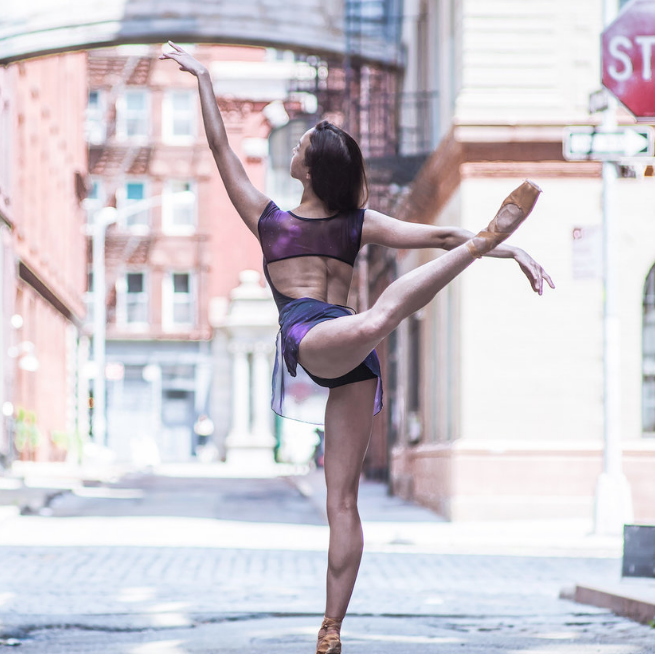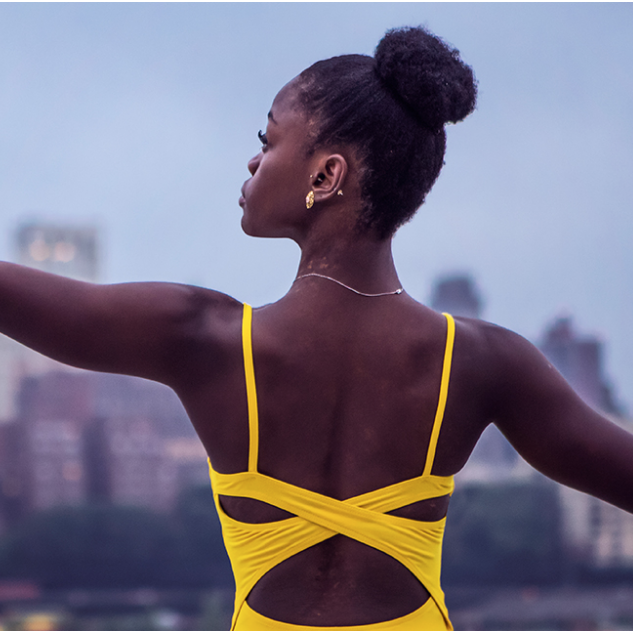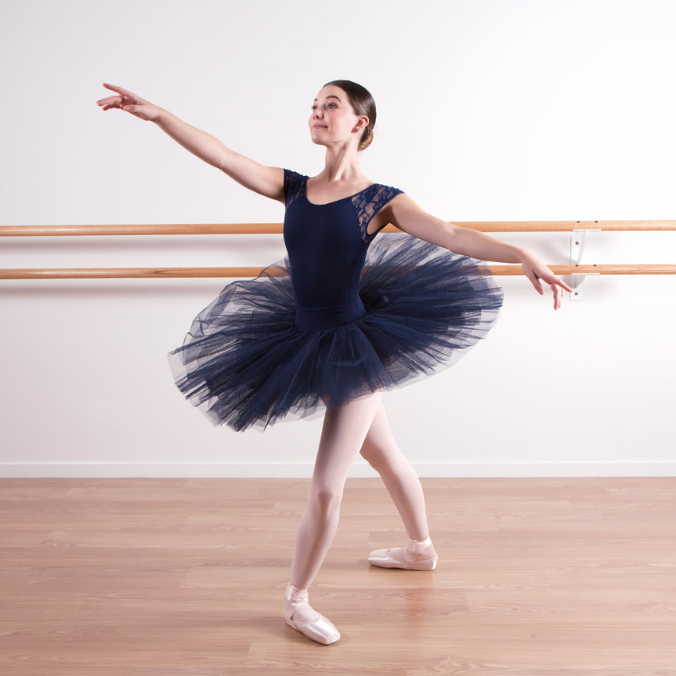Energetiks Talks with Melissa Hamilton
Photo: Simon Fowler Photography
Every success story in the dance world is nothing less than a spectacular triumph. There are no meagre victories in an arena where the stakes are high enough to inspire both rapturous ambition and crippling anxiety, and in a world that raises children with the maxim of 'following your dreams', young dancers cut their teeth on the paradoxical reality that 'living the dream' is a far cry from achieving it. Of the thousands of kids that embark on the path of rigorous training every year in the hopes of a professional career in dance, only a fraction of them will see their fantasy come to fruition.
Every dancer who does get to step in front of a crowded audience, feel the electrified energy permeating through the theatre and hear the crowd hush in anticipation of their performance is a triumphant exception to the norm. Some dancers owe their success largely to - aside from the mandatory quota of exceptional talent - sheer good luck. An astute parent who put them in classes early enough, good genes, long legs, a clean slate of health, great teachers, an aptitude for flexibility and musicality, as well as good timing and financial stability. These gifts of good fortune are so decisive to a dancer's chances of success, that occasions when you hear about someone defying any one or more of these factors is a relished rarity, and few dancers stand as clearly and as jubilantly as a master entirely of their own success as Melissa Hamilton. The Irish-born, pixie faced beauty was plunged into the ballet world at the remarkably late age of sixteen after only a few years of casual classes once a week in a local church hall. Hamilton's parents had insisted that academia come first (which she excelled at), and unperturbed, the ballet-newcomer set out to audition for full-time dance schools after graduating, despite being years behind in training. After initial rejection from the Royal Ballet School, Melissa was accepted by the Elmhurst School of Dance in Birmingham, who saw enough potential to offer Melissa a full scholarship.
The victory was quickly overshadowed though by the sheer scale and overwhelming challenges of what Melissa would have to overcome in order to catch up to her peers and succeed in this new world she found herself immersed in. After a year of gruelling training and giving her all, Melissa's teachers delivered their bluntly honest opinions; she was advised to give up. It was her teachers' belief that there was simply too much to catch up on, and that she would be better off giving up on the dream. The news was devastating to the seventeen year old. When the people you're relying on to help you succeed don't believe you've got what it takes... what do you do? Calling it quits might have been the reasonable response for most, yet Melissa refused to be discouraged.
Then, in a fortunate turn of fate, Melissa took her very first class with Masha Mukhamedov, a former Bolshoi Ballet soloist who had just begun teaching class at Elmhurst. The bond was immediate; Masha saw the determination and the spirit Melissa possessed - believing in her abilities, and in return Melissa put her complete trust in Masha. Melissa began to enjoy dancing again rather than dreading it, and suddenly everything she'd been struggling for didn't seem so unachievable anymore... So when Melissa then found out that Masha was set to move to Athens the following year with her husband, Irek, the seventeen year old demonstrated her courage and total commitment once more; she followed.
Alone and isolated in a foreign country, she focused on her private classes with Masha, and after ten months - with little thought of winning - Melissa entered the Youth America Grand Prix to gain some experience and measure her progression. She did win though, and was quickly offered a contract to join the prestigious American Ballet Theatre Studio Company - a huge honour. Melissa had never been one to compromise on her dreams though, right from day one. And now, with success within grasping distance she made another brave decision, rather than accepting the contract she steeled herself to audition for the Royal Ballet, the company that had been her first choice from the very beginning. In the midst of a whirlwind of possibilities that The Grand Prix had opened up so unexpectedly, Melissa flew back to Rome and put together a DVD with Masha's help to send to the Royal Ballet's Artistic Director, Monica Mason. She was very promptly extended an invitation to come and take class with the company in London, and once there - after taking class with the Royal Ballet's dancers - Melissa received a contract offer. The rest as they say, is history. The drive and commitment that propelled Melissa through her training and led to the Royal Ballet saw her going from strength to strength over the following years. Rising through the ranks from First Artist in 2009, Soloist in 2010 and First Soloist in 2013, before accepting an offer to join the SemperOper Ballett in Germany as a Guest Principal Artist in 2015, and never looking back.
Melissa's story reads like a fairytale, complete with an unlikely beginning, formidable challenges to overcome, silver linings that save the day and a 'Happily ever after', but the most magical part of Melissa's tale, is how it wasn't magic at all. There's nothing more rousing than the story of someone who didn't listen to the critics, or get discouraged by the odds, and who went for what she really wanted with utter, wholehearted determination... and no fairy dust in sight.
We caught up with Melissa in the midst of rehearsals for her debut as Aurora in The Semperoper Ballett's performance of Sleeping Beauty to talk about the journey so far, and her aspirations for the future. See below:
Q: What first got you started with dancing, does anyone else in your family dance?
My Mum sent myself and my sister to ballet classes as an after school activity when I was 4. No-one in my immediate or extended family had any link to ballet but my Mum had always wanted to take dance lessons as a child.
Q: Your journey with dance is quite unique, it wasn’t until sixteen that you were able to commence training more than once a week, what was it like to immerse yourself at that age?
At 16 I threw myself totally into a new and different world. Having been at regular high school, taking ballet class once a week up until that point, I was strangely only excited at the prospect of beginning a new life..even though I was going in completely blind and unprepared !
Photo: Keith Dixon photography
Q: It must have been overwhelming at times, being surrounded by peers who had been training intensely since they were very young, what kept you motivated and how did you cope with those days when you did feel disheartened?
I finally found myself doing something I wanted to give 100% of myself and my efforts to, which was a first for me - I lost (and still do) interest in pretty much everything else very quickly. This pushed me on and against all the other factors that were against me.
Q: In what moments are you happiest as a dancer?
When I am in an environment where I am being encouraged, pushed and appreciated.
Q: After a year of full-time training you were advised that you wouldn’t be able to catch up. A lot of people would have considered discontinuing after that, but you persevered, which is extraordinary, because it’s that kind of tenacity that a lot of dancers struggle with when it comes to receiving criticism, rejection or unsuccessful auditions. Do you have any advice for how to cope with these discouragements?
To always remember that what you are told is an opinion and not a fact. People tend to judge by what they already know and what they have seen before.
My own want, desire and stubbornness in pursuing a career as a professional ballet dancer was stronger than the vision of the people that were telling me I couldn't do it..plus I knew how much I was willing to put in to make it happen!
Performing La Bayadere with István Simon. Photo: Ian Whalen, courtesy of the Semperoper Ballet
Q: Was there a specific moment when you realized for the first time that you really had the ambition and the skill to make this a career?
I don't think I could pin point a specific moment. There seemed to be a natural snowball effect after I chose to pursue private training in Athens, to winning Grand Prix at YAGP, to getting my contract with the Royal Ballet. My focus and attention was more on making continuing progress and improvement than getting to the "it's done" point.
Q: Masha Mukhamedov had a crucial part in your training and helping you to reach your full potential, it’s so seminal to find the right teacher as ultimately your future is in their hands. What are qualities you think students should look for when finding a dance teacher, and what worked so well between Masha and you?
Trust, and give & take. For a teacher - pupil/ coach - dancer relationship it has to be 50:50. Masha didn't diminish my goals and dreams, instead she worked with me pushing me further than I could push myself to make them happen..yes she thought I was crazy, but she could also see the lengths I was willing to go to to make them happen - the amount of work that she put in was expected back from me and she gives nothing but 100% to her students.
You need a teacher that will push you beyond what you believe to be your limits, to not settle for what they see you as in front of them, but help you fulfill what you have the potential to become.
As Manon. Photos: Ian Whalen
Q: How do you approach an audition so that you might perform your best, and how do you feel about the audition process as a whole, stressful or enjoyable?
Of course auditioning is stressful ! In effect you are putting yourself in front of directors to say "Yes, I like you..I want you" or "No, you have nothing to offer me."
I think it's vital to not take rejection personally. Treat an audition as an experience to learn from. Watch the other dancers - see how they approach the exercises, what you like about how they dance, what you don't. QUICKLY pick up what the teacher of the class is asking from the exercises they set. It's also good to watch the company you are auditioning for in performance to get a sense of their particular style and so the director's taste.
Q: Which artists and people have had the most impact on you as a dancer?
I give huge credit to Wayne McGregor for giving me my big break in "Infra" in my 2nd year as a corps de ballet member in the Royal Ballet. Also my directors over my career so far - Monica Mason, Kevin O'Hare and currently Aaron Watkin for giving me the opportunities to dance the roles I have and what I am currently dancing. The choice of what roles a company dancer gets to perform ultimately lies in the hands of the director of the company.
Q: It must have been so exhilarating when you were accepted into the Royal Ballet, after chasing that dream from the start, what did you do when you got the news?
Monica Mason the then director of the Royal Ballet told me on the spot after I'd taken company class that I would have a corps de ballet contract with the company beginning the following season.
I called my parents who had made the trip to London with me and said we needed to find somewhere to celebrate!
I was in a state of shock and disbelief for a good while after.
Q: And now, after working as a guest Principal Artist with the SemperOper Ballett, you’ve accepted a position there permanently – Congratulations! – What was it that you fell in love with, and how was the move to Germany (do you speak German)!
Aaron Watkin the director of Semperoper Ballett has and is giving me opportunities that I wasn't getting and couldn't guarantee would come in the future at the Royal Ballet.
It was a huge risk to take as I was going to throw myself into repertoire I had never had the chance to explore but luckily I feel supported and encouraged by the staff and colleagues to take on the challenge here in Dresden.
My German is still very minimal and I will have to take up German lessons next season to be able to have a conversation...luckily the company all speak English!!!
Photo: Simon Fowler Photography
Q: What have been the biggest highlights for you as a dancer so far, and what are your aspirations for the future?
Dancing R&J Balcony pdd with Roberto Bolle In Arena di Verona infront of 13,000 people will stay with me forever as a massive highlight. Manon with Jiri Bubenicek for his farewell performance was very special and also making my debuts in La Bayadere and Sleeping Beauty this season.
I hope I can continue to get on stage doing as wide a spectrum of repertoire as possible.
Q: What are the most valuable lessons that you’ve learned through your experiences in the dance industry so far?
That anything is possible if you want it badly enough and are willing to do more than it takes to make it happen!
Q: What (if anything) would you like to see change about the dance industry, or the perception/role of classical dance today?
I feel a lot is being done to make classical ballet more attainable thanks to social media and digital broadcasting. I would love to see more behind the scenes and the off stage aspect of our lives put out to the masses. The daily grind and the reality behind the curtain can show a very different side to the perfection we as ballet dancers are ceaselessly trying to achieve!
Photo: Spring69
Q: What helps you keep yourself healthy and happy with such a physically and mentally demanding lifestyle?
Having a very small, tight group of friends that I can count on for support and perspective.
Q: What makes you laugh?
I usually laugh at myself ..sometimes in retrospect, often in my first attempts at any ballet choreography!
Q: Which is most enjoyable for you; class, performance, or rehearsals?
That's a hard one. It really depends on what it is dancing. I love the process of rehearsing- feeling and seeing the daily progression, finding aspects to layer what it is I'm dancing, working together with a coach and partner to get the best out of myself. Achieving something that on the outset appeared impossible.
Performance gives me something entirely different though - you step into a different world when you go on stage which is incomparable to being in the studio. However I do generally prefer being on stage after I've done my role debut performance.
Q: Do you have a pre-performance routine?
The only thing I always try to do before performance is have a sleep, even if it's a 20 minute power nap.
Photo source: Spring69
Q: For you, what has been the most challenging hurdle on the road to success and how did you overcome it?
To drown out the opinions of those who said I couldn't do it. It has been a long process..there is a big difference between stubbornness and self belief! For a long time my drive was that I wanted to prove that I could have a career in the ballet world. It became a welcome shift when I started doing it purely for myself and to fulfill my own ambitions.
Q: Describe your dream costume:
Something with feathers ;)
And last but not least: do you have any final advice for our readers who are aspiring dancers, or who may have started dance later than most?
Starting late, in the ballet world especially, puts you at a disadvantage. You have to be willing to push yourself to go beyond "the norm" in respect of how much time, effort and brain power you can give to it.
The amazing thing about this career though, is that you can get it all paid back in just a few fleeting moments on stage !
Photo: Simon Fowler photography
Read More:
















